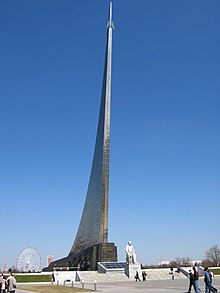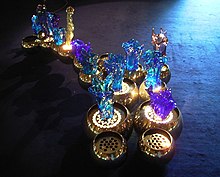Cosmonaut Museum
The Cosmonaut Museum in Moscow documents Soviet space travel , its technology - from the R-7 to the Sputnik to the Mir space station and the Buran space shuttle - and its culture. It is located in the northeast of the city center, close to the exhibition site of the Achievements of National Economy (VDNKh), right by the metro station of the same name .
architecture
The museum consists of a low-rise building with the exhibition and the monument To the Conquerors of Space on the roof of the building. This consists of a parabolic curved and tapering tower, at the top of which a symbolic rocket rises into the sky at a height of 107 meters, as if on an exhaust jet. Following a suggestion by Sergei Korolev , the roof and monument are clad with titanium plates and thus create a silvery sheen depending on the incidence of light. The memorial was designed by the sculptor A. P. Faidysch-Krandijewski and the architects A. N. Kolchin and M. O. Barschtsch .
On the back is a statue of the Russian rocket pioneer Konstantin Eduardowitsch Ziolkowski , who was born in 1857 and who developed the fundamental principles of space physics until his death in 1935, such as the basic rocket equation in 1903 .
Behind the statue begins Kosmonautenallee , an avenue open only to pedestrians with busts of Soviet space pioneers and cosmonauts, including Sergei Korolev , Yuri Gagarin and Valentina Tereschkowa . Cosmonaut Day is celebrated here every year on April 12th in memory of Gagarin's flight.
The entrance of the museum is located on the opposite side and is directly from the metro station VDNKh made accessible. It first leads into a semicircular exhibition room. From there you get to the central, darkened main room with further exhibits, niches with projection surfaces and the large cosmonaut sculpture. Other adjoining rooms are not open to the public and contain an archive and warehouse.
history

The VDNKh exhibition ( Exhibition of the Economic Achievements of the USSR , Russian ВДНХ) emerged in 1959 from the Agricultural Exhibition of the Soviet Union . Since then, it has been best known for the space exhibition pavilion and has attracted a steady stream of visitors. Copies of the Sputnik satellite, training equipment to prepare the cosmonauts , space suits and parts of the Soyuz rockets could be viewed here.
The monument to the conquerors of space was built in 1964 to complement the exhibition to reflect the increasing popularity of space travel after the success of Yuri Gagarin in 1961 as the first person to enter space. The museum was also planned from the start, but it took until April 10, 1981, two days before the 20th anniversary of Gagarin's flight, until it was finally completed and could be inaugurated. The museum was intended to provide further information on technology and history, but also to express the cultural significance that was attached to space travel in the USSR .
After the collapse of the Soviet Union in December 1991, the exhibition grounds themselves were rented out as a trading center and then expanded into an exhibition center from 2005; in the meantime it was called WWZ ( All-Russian Exhibition Center , Russian ВВЦ), but since 2014 again VDNCh. The cosmonaut museum remained intact throughout the period and until 2006 presented the material from the period from 1959 to 1991, and from 2009 the current extensive exhibition.
exhibition
Annually changing themed exhibitions are shown in the front half-ring, mainly in the form of photos and documents. This included the Apollo Soyuz project from 1975, international collaborations in research work on the Mir space station and the development of the Buran space shuttle .
The main hall is designed differently than in the functional style of the front part. It welcomes the visitor in the semi-darkness, with strange, brightly colored glass sculptures on the floor. The exhibition objects are arranged on both sides and illuminated in color like on a stage: Different spacesuits for both sexes, but also for dogs like Belka and Strelka. In addition to a Sputnik, there are parts of the landing capsules by Juri Gagarin and his successors, as well as replicas of the man-sized lunar robot Lunochod and other probes from the Luna range and the Mars and Venus probes . On benches, the visitor can follow film documentaries about the history of Russian space travel. On a series of time tables, in turn, technical and scientific developments are shown that created the prerequisites for space travel.
Bilingual on-board manual of the Apollo-Soyuz project
Lunochod lunar robot 1
Political graphics - non-political art
The museum's fund also includes an extensive collection of posters using space travel as a political symbol. It becomes clear that the departure into space in the Eastern Bloc was, in addition to the proof of technical skills, above all a symbol of social renewal - for example during the change from Stalin's to Khrushchev's policy. A mood of optimism is also conveyed stylistically and, not unlike Western visions, accompanied by futuristic elements. The youth was specifically addressed - it should be they who, according to the ideas at the time, would carry out the successful implementation of communism in the 1980s .
The architectural form of the rejuvenating rocket tail is used partly openly, partly subtly as a recurring design element. In addition to factual, graphic motifs or heroic gestures, there are also comic-like elements, for example when the Soviet space probe, with a wink of surprise, discovers that there is no (western) god in heaven.
The numerous works of art on space formulate a position that is related at first glance, but contradicts one another on closer inspection: While socialist realism was otherwise the officially prescribed art trend, a wide range of modern , abstract styles, impressionism , expressionism , and then also elements of the psychedelic art that was popular in the West in the 1960s.
Furthermore, the museum shows works of cosmonaut art - here space travelers themselves became artists and, it was reported, processed the impressions from their space flights. Most famous was Alexei Leonow , who on March 18, 1965 was the first person to go on an extraboard mission, left his spaceship Voschod 2 and floated freely in space. The motifs of the cosmonaut art are consistently non-political, only the motif of the dove of peace appears occasionally. The world of the cosmos allowed freedoms that were otherwise not granted in Soviet society.
Finally, the museum also has a souvenir shop, which, in addition to the usual utensils, the catalog of space art or oversized Soyuz matches, also offers objects such as wooden jewelry boxes that have been hand-painted with space motifs by artists.
The cosmonaut

The central object of the exhibition, opposite the entrance, illuminated by numerous spotlights, is a six-meter-high sculpture of a cosmonaut. He's standing casually and seems to be smiling, his arms spread wide. Behind it is a suggested globe made up of different living beings that are interwoven. Both objects are cast from bronze . Behind it is a wall of colored glass windows, which are framed asymmetrically in lead like colorful church windows and are lit as bright as day from behind.
Renovation and reopening in 2009
In 2006 Moscow's urban architect Alexander Kuzmin presented his plan to build a circular square with a representation of the solar system and a statue of Korolev at the museum.
In autumn 2006 the museum was closed for the renovation work and parts of the exhibition were moved to pavilion 33 of the neighboring WWZ. There, after 15 years of absence, the Vostok rocket was set up again.
On April 12, 2009, which celebrates Gagarin's flight every year as Cosmonauts Day in Russia, the museum was reopened after extensive renovations. There is now three times the space available, and technology, history and personalities of Russian space travel are extensively presented on two floors. In addition, the US Apollo and the Space Shuttle as well as the current Chinese developments are presented in detailed models, as is the ISS .
A series of multimedia installations invite you to explore technical details interactively; Probes and components from Soviet and Russian space travel are shown in the original. The exhibition space for cosmos art and graphics has also been expanded and a café has been set up for visitors. The space behind the entrance was also renovated and expanded - busts of other protagonists of Russian space travel are set up in a circle around the Ziolkovsky monument, and a brass statue of Sergei Korolev , to whom a separate room in the museum is dedicated, is placed on a separate plinth .
Web links
- Russian website of the museum - English language version
- Video tour through the Cosmonaut Museum in Moscow (in German)
- Museum of Cosmonautics at Google Arts & Culture
Coordinates: 55 ° 49 ′ 21.3 " N , 37 ° 38 ′ 22.5" E









